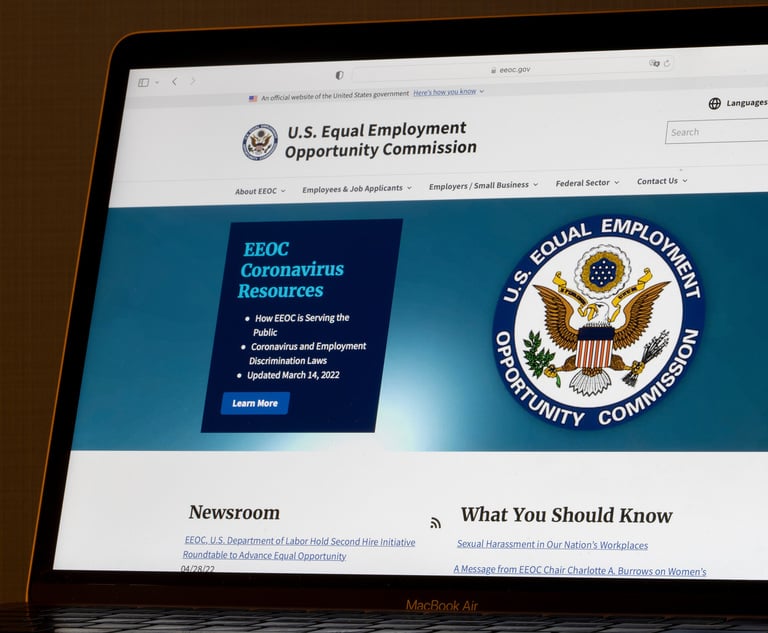A measure intended to extend job protections to pregnant workers has been hit with another challenge, one claiming that the Equal Employment Opportunity Commission exceeded its statutory authority when it applied the measure to an employee seeking an abortion.
Plaintiff Brandon & Clark Inc., a Lubbock, Texas, company that repairs electrical equipment, filed the latest suit in the Northern District of Texas, represented by the Texas Public Policy Foundation.
The Pregnant Workers Fairness Act requires employers to provide accommodations to conditions regarding to pregnancy, childbirth or related conditions, unless the accommodation will cause the employer an undue hardship.
Under the rule, the phrase “related medical conditions” is defined as “lactation, miscarriage, stillbirth, having or choosing not to have an abortion,” among other things.
The Brandon & Clark suit argues that the regulations’ accommodation component requires it to provide leave for an employee to obtain an abortion.
The suit says Brandon & Clark does not currently allow employees to take leave to receive an elective abortion, and it will not change its policy to provide such accommodation unless it is forced to do so by law.
Brandon & Clark seeks a finding that the PWFA is unconstitutional because not enough lawmakers were on hand when the vote was taken.
The law was adopted under a measure enacted during the height of the COVID-19 pandemic, which allowed votes by proxy. But the suit claims that rule was no longer in effect when the PWFA was approved as part of the Consolidated Appropriations Act of 2023. Only 201 members of the House of Representatives were present in the chamber when the vote was taken, which Brandon & Clark claims was a violation of the Quorum Clause of the U.S. Constitution.
“Congress was on notice for two and a half years that its proxy voting rule was constitutionally suspect,” TPPF attorney Eric Heigis said in a statement. “Yet in December 2022, when the rest of the world had returned to normal, Congress was still allowing its members to phone it in. This case advances a simple principle: the constitution requires members of congress to show up to do their job.”
The EEOC referred a question about the Brandon & Clark suit to the Department of Justice, which did not respond as of press time.
The Brandon & Clark suit is not the first to be filed over the PWFA.
Attorneys general from 17 states filed a challenge in the Eastern District of Arkansas in April, but that suit was dismissed for lack of standing and lack of showing an irreparable harm. The Eighth Circuit declined to issue an injunction barring enforcement of those regulations on June 28.
In a separate case, also in the Northern District of Texas, Texas brought a challenge to the PWFA. That case is pending, and the court has entered an injunction against enforcement of the statute, but it applies only to Texas as an employer.
And in yet another case, filed in the Western District of Louisiana, Louisiana and Mississippi filed a suit in May. That case is pending, but the court has enjoined enforcement of the statute in those two states and against a fellow plaintiff, the U.S. Conference of Catholic Bishops.
 Alexa Miller of Faegre Drinker Biddle & Reath. Courtesy photo
Alexa Miller of Faegre Drinker Biddle & Reath. Courtesy photo
But beyond those narrow exceptions, the PWFA and the enabling regulations remain in effect nationwide.
The case filed this week is the first of this group to challenge both the PWFA and the EEOC regulations, said Heigis of the TPPF. His group plans to file a preliminary injunction motion in that case, Heigis said. But his group has no problem with the content of the statute, he said.
“So it doesn’t matter what the content of the act is. If the act violated the quorum clause in the way it was passed through Congress, then it’s invalid, no matter how laudable the goals of the legislation might be. If a law is unconstitutional, it’s unconstitutional,” Heigis said.
The PWFA is “very common sense, reasonable, practical and, quite frankly, easy to accommodate,” said Alexa Miller, a partner practicing employment law at Faegre Drinker Biddle & Reath in Florham Park, New Jersey. But under the act, people are still deemed qualified if the inability to perform an essential function is for a temporary period, and that function could be performed in the near future, Miller said.
“And the final rules have sort of delved into what exactly does that mean, and they take a very expansive view of the term limitation,” Miller said.
If a job applicant can’t perform a key function of the job, employers previously didn’t have to accommodate them, Miller said. Now, under the new regulations, if someone can’t perform a key function, the employer may still have to hire them if the inability to perform is no more than 40 weeks, she said.
 Kate Mueting of Sanford Heisler Sharp.
Kate Mueting of Sanford Heisler Sharp.
“This is a significant shift in how employers typically navigate accommodations,” Miller said.
Kate Mueting, a partner at Sanford Heisler Sharp in Washington, D.C., said she thinks the government can prevail over claims that the legislation was not intended to encompass abortion. Mueting said the Pregnancy Discrimination Act of 1978, refers to “workers who are affected by pregnancy, childbirth or related medical conditions,” the same language used in the PWFA, and courts have held that that language encompasses nondiscrimination against a worker’s abortion.
“So when Congress used that language again, it used language that already had a meaning. It was already kind of a legal term of art that already included those seeking abortion. So I would submit that congressional intent of the Pregnant Worker Fairness Act is clear,” Mueting said.
Mueting said the act “is not controversial. It was passed with bipartisan support. It is clear that when workers who are pregnant are able to drink water, to occasionally sit down, and when employers are required to provide those accommodations that have to be reasonable and have to be without an undue burden, it’s better for everyone.”
NOT FOR REPRINT
© 2024 ALM Global, LLC, All Rights Reserved. Request academic re-use from www.copyright.com. All other uses, submit a request to [email protected]. For more information visit Asset & Logo Licensing.


 Credit: Tada Images/Adobe Stock
Credit: Tada Images/Adobe Stock





